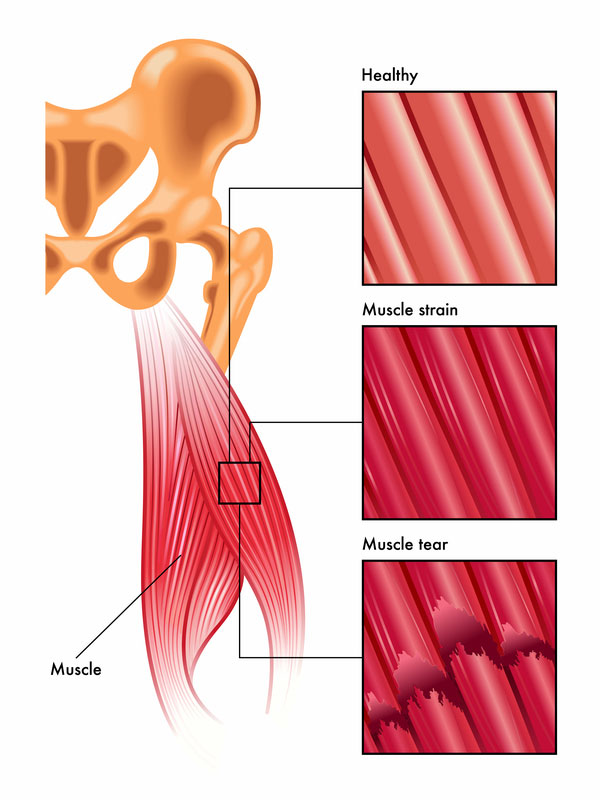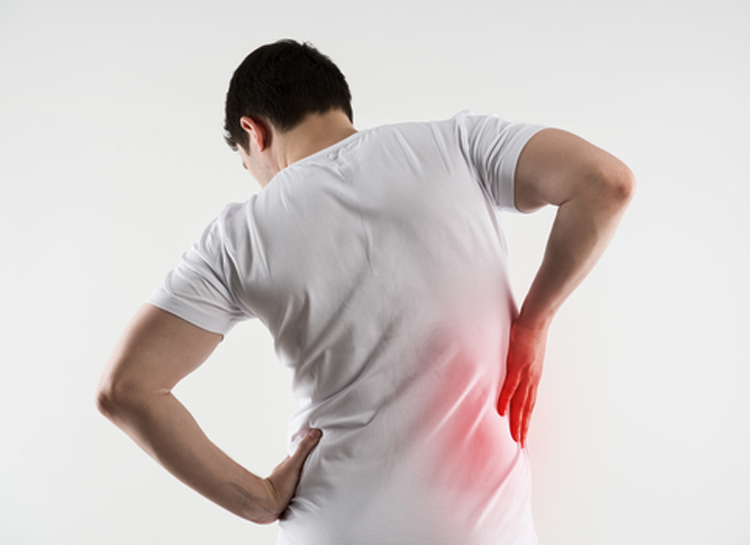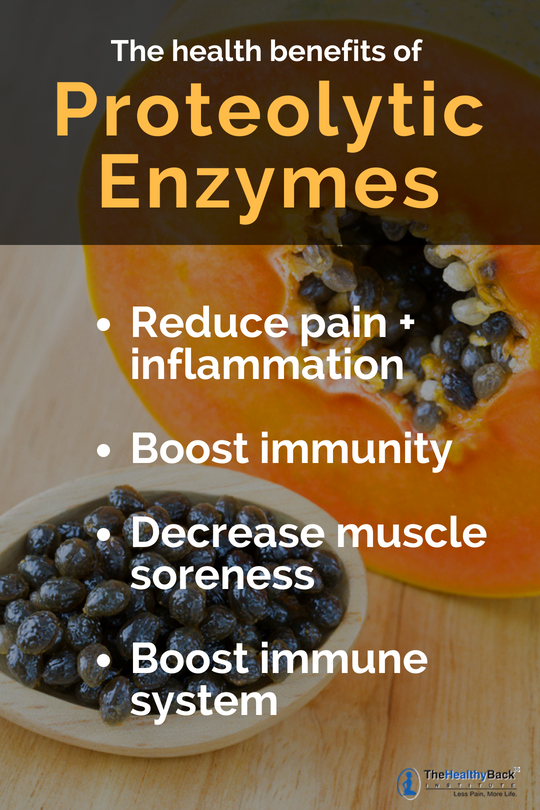
Medically reviewed by Dr. Brian Paris, D.C on Nov. 6, 2018.
Did you know that back pain is one of the most common reasons people go to the doctor? It’s true… millions of Americans trudge into doctors’ offices, hospitals, and clinics every year, desperate for relief from back strains and sprains.
And yet, they continue to suffer from pain, stiffness, tenderness, and limited mobility.
Why? They’re looking for answers in the wrong place. Unfortunately, all doctors have to offer are short-term solutions. But you are dealing with a long-term problem.
If you’re dealing with stubborn back pain, then you’ve come to the right place.
Table of Contents
[2] How do I know if I strained my back?
[3] What’s really causing my back pain?
[4] How to treat muscle imbalance
[5] How to treat a painful muscle strain
[6] Nature’s anti-inflammatories – proteolytic enzymes
[7] Can an enzyme really shorten my healing time?
[8] My top 5 recommendations for back strains
What is a back strain?
A back strain is an injury to the muscles or tendons in your back. They are sometimes called pulled muscles, because your muscle fibers pull apart and split. Strains look and feel similar to sprains, which are injuries to your ligaments.
Back strains can be mild, in which a handful of muscle fibers tear apart, or severe, in which the entire muscle breaks into two pieces.
It is important to remember, however, that even a small tear can cause extreme back pain.
That’s because the soft tissues around your spine play a major role in your physiology.

The muscles in your back work to hold you upright. The tendons attach your muscles to your spine. And the ligaments hold the bones of your spine together.
Your back has worked hard for you, allowing you to twist, turn, and lift your way through your first few decades.
But after a while, it is more easily worn out.
And it becomes vulnerable to injury.
Lower back muscle strains are particularly common. This area, known as the lumbar region, supports most of your upper body weight.
Key takeaway: Back strains occur when you tear a muscle or tendon in your upper or lower back.
How do I know if I strained my back?
Strains and sprains are the most common cause of back pain in adults.
Sometimes they result from an obvious injury…
Have you been lifting heavy boxes? Pushing it a little too far in hot yoga? Or maybe taken a tumble down your front steps?
Don’t worry, these things happen to the best of us.
Other times, however, a strained back muscle can seem to come out of nowhere. In such cases, you probably noticed the pain more than the injury itself.
Maybe you took an awkward step. Overreached. Or twisted in a sudden motion.
A severe tear in a muscle, ligament, or tendon can sometimes produce a popping noise as the tissue snaps apart. But in most cases, lower and upper back muscle strains just cause pain.
The onset of pain can be immediate, or it can take several hours.
Does this sound familiar? You go out to shovel the driveway at night and everything seems fine… but when you wake up in the morning it’s a whole different story!
That’s a strained or sprained back.
(It is not usually possible for you to determine whether you’ve torn a muscle, tendon, or ligament.)
Other signs that you have a back strain or sprain include:
- pain that gets worse when you move and feels better when you rest.
- muscle spasms (quick uncontrollable muscle contractions).
- muscle stiffness.
- decreased mobility, including trouble walking, bending, sitting, or moving side-to-side).
You may continue experiencing these intense symptoms for two to three days. After that, the pain should begin to decrease.
Most people recover from back strains within three to six weeks.
But remember, just because the pain is gone, doesn’t mean the problem is too!
The underlying cause of your lumbar strain must still be addressed.
Key takeaway: A back strain can cause intense pain at first and mild to moderate pain for the next several weeks.
What’s really causing my back pain?
Now that you know what a back strain is and what it feels like, let me tell you a little bit about the root of your problem: muscle imbalance.
The reason that most back strain treatments fail in the long-run, is that they are only treating the end result of your problem—your pain.
If you don’t treat the underlying cause of your injury, it’s just going to happen again and again. This puts you at risk of developing chronic (long-term) pain.
According to a study in the Archives of Internal Medicine, a well-respected medical journal, as much as 44% of working people who have an episode of lower back pain will have a second episode within one year.[i]
In fact, chronic lumbar pain is on the rise. More than 10% of people never recover from back pain, it simply becomes a chronic, lifelong issue.[ii]
Don’t want this to happen to you? Then it’s time to fix your underlying condition.
A muscle imbalance occurs when the muscles in one area of your body get tight or overdeveloped, while their opposing muscles weaken and wither.
These imbalances can happen anywhere in your body.
A good example is the quadricep muscle in your thigh. When the outside of your quad is overdeveloped but the inside is weak, it can pull your knee out of alignment.
When one part of your body gets knocked out of alignment, there are repercussions everywhere… a misaligned knee, leads to misaligned hips, leads to lumbar imbalance.
While you may have strained your back reaching up to clean the ceiling fan (it happens, trust me), your problem began far earlier than that.
Improper alignment puts you at risk of injury and, if left untreated, will continue to cause you problems in the future.
Key takeaway: A muscular imbalance can throw your body out of alignment and put you at risk of injury and reinjury.
How to treat muscle imbalance
Muscle imbalance is different for everyone, which means your back strain treatment should be designed specifically for you.
A comprehensive postural assessment can help you determine which areas of your body are out of balance.
This assessment can help you narrow in on the areas that need the most work and the areas that need to be left alone…
Without this knowledge, stretches and exercises can actually do more harm than good.
Muscle Balance Therapy™ is an individualized program designed to help get your body back in balance.
With a targeted set of exercises and stretches, you can take the stress off of your back muscles and prevent future strains.
Key takeaway: Muscle Balance Therapy™ is a targeted approach to muscle imbalance that will have you feeling and moving better than you have in years.
How to treat a painful muscle strain

Trust me, I get it. You’re in pain today and you’re looking for relief.
While correcting your muscular imbalance is going to improve your quality of life and prevent future injuries, it’s not going to help you right now.
A back strain is an injury, and like all injuries, it will take your body some time to heal.
Let me tell you a little bit about the healing process and clue you in on the secret to a quick recovery…
Back strains and sprains cause inflammation in and around the lumbar region.
Inflammation is an important part of your immune system. It helps protect you from harmful viruses and bacteria, cushions your injuries while they heal, and helps repair cellular damage.
Too much inflammation, however, can cause unnecessary pain and swelling.
And when that inflammation lingers, it can lead to long-term stiffness and muscle atrophy. Of course, stiff, weak muscles are more prone to reinjury.
So, what are you supposed to do?
You could take nonsteroidal anti-inflammatory drugs (NSAIDs) like ibuprofen or naproxen. These over-the-counter (OTC) medications can reduce pain and inflammation, but they cause a heap of dangerous side effects.
Did you know… even short-term NSAID use can increase your risk of heart attack and stroke?[iii]
Or, you could ask your doctor for prescription painkillers, or muscle relaxers. But then you risk falling prey to their highly addictive properties.
After years of research into back pain, I’ve found that I don’t need to fill my body with pharmaceuticals, I can live a pain-free life without them…
And so can you.
Key takeaway: A short period of inflammation is a normal part of the healing process, but too much inflammation can lead to chronic back pain.
Nature’s anti-inflammatories – proteolytic enzymes

I want to let you in on a fairly well-kept secret—one that will help you fight pain and inflammation without the use of dangerous pharmaceuticals.
They are called proteolytic enzymes.
Never heard of them? You’re not alone.
Proteolytic (proh-tee-uh-lid-ik) enzymes are found naturally in the body and in certain tropical fruits, namely pineapple and papaya.
The medicinal use of pineapple-derived proteolytic enzymes traces back to the ancient civilizations of Central and South America.
In the 16th and 17th centuries, pineapple was introduced to Asia and the Pacific Islands. Bromelain, a proteolytic enzyme derived from the stem and fruit of pineapple, soon became a staple of traditional folk medicine.
It’s only in recent years, desperate to find a better option for people in pain, that scientific researchers have begun looking at the potential of proteolytic enzymes.
Unfortunately, their remarkable scientific findings have not been widely disseminated within the medical community. Most doctors haven’t even heard about them!
Studies show that proteolytic enzymes are as effective as NSAIDs at reducing pain and inflammation. For some people, they are more effective than NSAIDS.[iv]
Other research suggests that proteolytic enzymes work directly on pain receptors to reduce pain from muscle strain and inflammation.[v]
Key Takeaway: Proteolytic enzymes are a natural alternative to NSAIDs that can reduce back pain and inflammation.
Can an enzyme really shorten my healing time?
Enzymes are substances that work to speed up chemical reactions in your body. There are thousands of different enzymes at work inside your body at any given time.
For example, there are many enzymes in your digestive system helping you break down the sugars, fats, and proteins that you eat. There are also enzymes in your liver that work to break down toxins in your blood.
Proteolytic enzymes are produced naturally in your stomach and pancreas. Their primary purpose is to help break down dietary proteins into smaller fragments known as amino acids.
But they serve another very important function.
Studies have shown that proteolytic enzymes work to break down extra fibrin.[vi]
Fibrin is a chemical in your body that helps your blood clot.
When you tear muscle fibers, your body sends fibrin to the injury to patch up the damage, kind of like a Band-Aid.
But your body doesn’t always know when to stop sending fibrin…especially if you’ve taken OTC pain relievers, which can confuse the chemical signals.
Think about your back injury like a cut on your finger. One Band-Aid is all you need.
One hundred Band-Aids would actually do more harm than good, because they could cut off your circulation.
It’s the same with fibrin.
A big glob of fibrin on your torn muscle prevents blood from flowing to your injured tissues and contributes to the formation of scar tissue.
Reduced blood flow to an injury means a slower healing time.
Fortunately, dietary or supplemental proteolytic enzymes can hasten your healing time by getting rid of excess fibrin. Click here to learn more.
Key takeaway: Proteolytic enzymes prevent the buildup of excess fibrin, which could speed up your recovery time.

My top 5 recommendations for back strains
I hope this article has given you a good overview of what happens when you strain your back, and why I worry about re-injury.
I’ve learned a lot over the years, but the one thing I’ve always known is how frustrating back pain can be.
But there is hope.
Here are my top five recommendations for you:
1) Give your body the time and support it needs to heal. Back strains can cause pain for several weeks at a time.
2) Recognize that your injury is not a one-time event, it is a symptom of an underlying muscle imbalance.
3) Avoid NSAIDs and prescription medications, they have many dangerous side effects and may even slow your healing time.
4) Proteolytic enzymes treat pain and inflammation just as well as NSAIDs. Don’t think you can eat a whole pineapple every day? No problem, you can get a concentrated dose in a dietary supplement.
5) Muscle Balance Therapy™ can help you get your body back in balance, reduce your pain and prevent future injuries.
Editor’s note: This article has been reviewed by a member of our medical advisory board. The content provided is for informational purposes only and should not be construed as medical advice. Please consult with your physician if you have any questions about your health.
Read more:
Why you should be eating more pineapple
6 best health benefits of turmeric
Dietary fixes that ease back pain fast
References:
[ii] Ibid.
[iii] Bally, M. et al.“Risk of acute myocardial infarction with NSAIDs in real world use: bayesian meta-analysis of individual patient data.” BMJ (2017): 357:j1909. 20 Sept. 2018.
[v] Ibid.




I am really thankful knowing that it is possible to get rid of these body pains that has been my problem for years. I don’t take much pain relievers knowing that it can damage my other internal organs.
Thank you for your kind words Reynaldo, we appreciate it.
Our Best Wishes
Admin(The Healthy Back Institute)